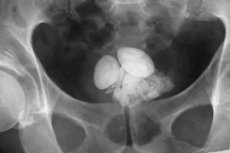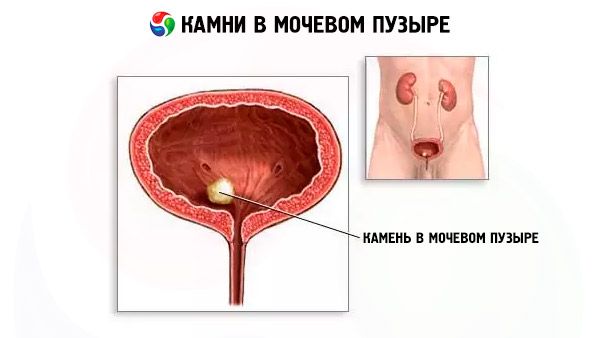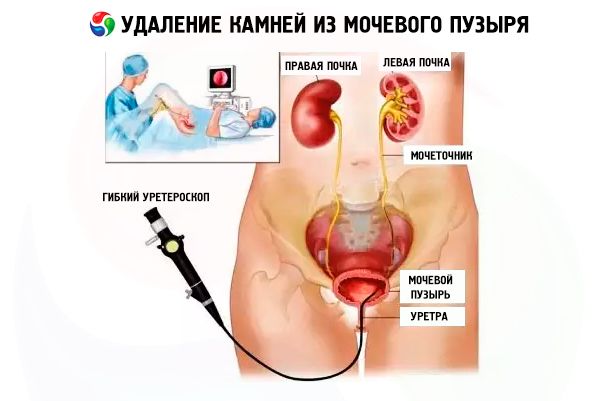Medical expert of the article
New publications
Bladder stone removal surgery: methods and rehabilitation
Last reviewed: 06.07.2025

All iLive content is medically reviewed or fact checked to ensure as much factual accuracy as possible.
We have strict sourcing guidelines and only link to reputable media sites, academic research institutions and, whenever possible, medically peer reviewed studies. Note that the numbers in parentheses ([1], [2], etc.) are clickable links to these studies.
If you feel that any of our content is inaccurate, out-of-date, or otherwise questionable, please select it and press Ctrl + Enter.

Cystolithiasis or the presence of stones in the bladder does not respond to conservative treatment in most cases. To date, there are no medications that are guaranteed to dissolve calculus deposits or prevent their formation.
Modern methods of removing stones from the bladder are less traumatic than traditional abdominal surgery. Open surgery is used extremely rarely these days, only in cases where the use of minimally invasive techniques is considered ineffective. Transurethral cystectomy schemes using endoscopic equipment are mainly used.
Stones can form directly in the bladder, or they can descend there from the kidneys. In any case, their removal is the first stage of treatment of urinary tract pathologies that led to the formation of stones.
Indications for the procedure
If conservative treatment is ineffective, chronic periodically worsening bladder infections, regular pain in the lower abdomen, blood in the urine or acute urinary retention, they resort to removing stones from the bladder.

Transurethral methods of stone extraction are indicated when they are visualized instrumentally and there are no obstacles to the extraction or independent exit of small particles of fragmented formations.
An indication for open surgery is the detection of a purulent inflammatory process or urethral stricture in the patient, the inability to visualize stones, as well as the presence of large stones that cannot be crushed.
Preparation
Using ultrasound and/or cystoscopy, visualization of stones, assessment of their size, location, organ condition, and likelihood of complications are performed. The method of surgical treatment is determined.
The patient's blood and urine are examined. The method of anesthesia (local, spinal, general) is chosen by the anesthesiologist, taking into account the type of surgical intervention and the patient's concomitant pathologies.
First, the patient must clear the intestines of feces using an enema or special medications.
Before open cystolithotomy, the pubic hair is removed.
 [ 7 ]
[ 7 ]
Technique bladder stone removal
Surgical removal of bladder stones in men, who suffer from urolithiasis much more often than women due to the anatomical features of the urethra, is the most reliable way to get rid of these formations.
The most common method of their removal in both sexes today is transurethral cystolitholapaxy (endoscopic removal of a stone from the bladder through the body's natural openings). A thin fiberglass (flexible) or metal (rigid) cystoscope is inserted into the bladder through the urethra, equipped with a video camera that allows visualization of the object and control of the operation. The cystoscope is brought directly to the calculus, through which an energy impulse is transmitted. Ultrasound and laser energy are currently used for crushing, allowing the stones to be crushed to the state of sand, which is washed out of the bladder with sterile liquid. Ultrasound is recommended for low-density stones. Laser technology is considered the most effective and accurate. The use of a laser beam does not damage nearby tissues, but precisely affects the object of crushing.

The method of electrohydraulic cystolithotripsy, which crushes a stationary stone on one side (the least strong), is considered more effective when placing stones in the ureter and kidneys. But it is also used to remove solid formations from the bladder.
A mechanical lithotripter is also used, which crushes the stones in stages. The specialist grabs the stone, takes it to the center of the bladder, and crushes it there, periodically washing the bladder to ensure good visual control. The procedure continues until the formations are completely destroyed. The disadvantages of the pneumatic method are the likelihood of soft tissue injury or throwing stones into the kidney.
After any endoscopic procedure, small fragments are removed using special devices or sucked out of the urethra with a vacuum. Since the operation is performed under absolute visual control, there is virtually no damage to the urethra. Contact lithotripsy is performed in a urology department hospital under general or spinal anesthesia, where the patient usually spends two to three days. Sometimes after the procedure, it is necessary to install a catheter in the bladder.
Remote lithotripsy is performed using a narrowly focused short-term high-pressure impulse (shock acoustic wave). This method is indicated in the case of secondary deposits, in the absence of obstructions to the outflow of urine and located in the neck of the urethra. Stones that have arisen against the background of prostate hyperplasia are not removed by this method.
This method of removal is the most gentle of all, requiring no preliminary anesthesia or, in the case of a low pain threshold of the patient, an analgesic injection is sufficient. When it is used, the integrity of tissues is not violated. The procedure of inducing a shock wave is controlled by ultrasound or X-ray equipment. Extracorporeal shock wave therapy can be performed on an outpatient basis. However, its main drawback is that fragments are not always completely removed from the bladder. The success rate of this procedure is slightly more than 50%. If the fragments of stones are not completely removed, the patient experiences complications in the form of periodic attacks of pain. This method is good for removing stones from the bladder in women, since the short and wide urethra makes it easy to remove fragments of crushed stones. In men, fragments can be removed 1-1.5 hours after the crushing procedure using a laparoscope (through micro incisions) or percutaneous puncture (pinpoint puncture).
Percutaneous suprapubic cystolitholapaxy is the operation of choice in childhood, as it allows for the urethra to be uninjured. In adults, this operation is performed to remove large stones without crushing (if crushing is contraindicated) or in combination with remote lithotripsy to remove large fragments that will not pass through the urethra. Stones are removed through a micro-incision in the lower abdomen and bladder lining. The operation is performed under general anesthesia in a hospital, and some time is required for recovery after the intervention.
Open surgery to remove stones is performed when it is impossible to reach them through the urethra (inflammation, narrowing, prostate adenoma). The procedure differs from the previous operation in its larger volume and, accordingly, trauma. The surgeon makes an incision in the lower abdomen and in the lining of the bladder, which makes it possible to examine it internally and remove hard formations, after which it is sutured and stitches are applied to the wound.
In order to prevent bladder dysplasia and the development of neoplasms in it in the presence of visually noticeable transformations of the internal lining of the organ, after removal of the stone, a tissue biopsy is taken for subsequent histological examination.
It is performed under general anesthesia, after the operation a catheter is installed for several days. During the operation, stones larger than 4 cm or those that have grown into the bladder lining are removed. This type of surgical treatment is chosen when it is necessary to simultaneously eliminate other pathologies - prostate adenoma, bladder diverticulum.
The main disadvantages of abdominal surgery are trauma and long-term rehabilitation.
Contraindications to the procedure
Removal methods using endoscopic equipment are not used to treat patients with anatomical features in the structure of the skeleton and urinary organs that block access through the body's natural openings to stones, large (more than 4 centimeters in size) and non-visualized stones.
Contact and remote lithotripsy are contraindicated for patients with pacemakers, tumor processes of the genitourinary organs, terminal stage renal dysfunction and decreased hemostatics.
The presence of a vascular aneurysm in the wave impact zone and mental illness are also factors that are unfavorable for performing operations.
Relative contraindications are pregnancy, active tuberculosis, acute infectious and inflammatory diseases of the genitourinary system, dermatoses and dermatitis in the wave impact zone, uncontrolled high blood pressure and other decompensated diseases of the cardiovascular system.
Percutaneous suprapubic litholapaxy is contraindicated in patients who have previously undergone surgical interventions on the pelvic organs and lower part of the peritoneum, insufficient filling and capacity of the urinary bladder.
Diabetics are not recommended to undergo open cystolithotomy. The advisability of this type of surgical intervention is considered individually, contraindications to it are common for abdominal operations.
Complications after the procedure are most common in patients over 55 years of age and due to non-compliance with the recommended diet. The high-risk group for postoperative complications includes people suffering from alcoholism, liver cirrhosis, cancerous tumors of various localizations, congestive heart failure and severe liver dysfunction.
Surgical intervention using endoscopic techniques is much more gentle. The ability to work and live in a normal rhythm in patients who have undergone surgery is restored a week after the surgery. The consequences of an open cystolithotomy procedure extend the recovery period to about a month or more. However, after this operation, a lower percentage of stones in the bladder recur.
The advantage of transurethral cystolitholapaxy over open surgery is the reduction of traumatic tissue damage and the virtual absence of complications. Subsequent observation of patients suggests that more than 90% of endoscopic surgeries performed were successful.
The most frequently recorded complications are urinary tract infections, much less frequently – damage to the bladder wall, development of sodium deficiency, bleeding.
Care after the procedure
After surgery under general anesthesia, the patient usually sleeps in the ward for some time. The body temperature usually decreases from anesthesia, so the patient must be well covered and not disturbed. However, he must be under the supervision of medical personnel, who monitor the body temperature and appearance of the patient. After the operation, an increase in body temperature may be observed. This is a normal phenomenon after anesthesia, both general and spinal, but its cause must be determined. The activity of the cardiovascular, respiratory and nervous systems is also monitored.
If necessary, after open surgery and sometimes after transurethral removal, a short course of bladder catheterization is performed periodically until the effects of multicomponent anesthesia have disappeared. A course of antibiotics for about five days may be prescribed to prevent urinary tract infection or if one is present before surgery.
After the stone crushing procedures, the patient is monitored for three weeks with an ultrasound examination of the bladder to ensure that the stone fragments have been eliminated. The medications prescribed by the doctor and the diet after the removal of stones from the bladder will help to remove them.
In case of urolithiasis, the diet should be varied, and the consumed volume of products should correspond to the standard daily norms of protein, fat and carbohydrate content. You need to drink liquids in such a volume that an adult excretes from one and a half to two liters of urine per day.
Food restrictions depend on metabolic disorders. If you are prone to the formation of urate stones, you should limit smoked meats and offal dishes, do not get carried away with strong broths, jellied meat and aspic. It is also better to limit the consumption of fried meat. Do not rely on canned meat and fish, generously season dishes with spices. It is better to eat lean fish. The formation of urates is promoted by vegetable proteins - mushrooms and legumes, as well as nuts. Alcohol is harmful in general, but in this case, it is better to prefer white wine and light beer.
Calcium oxalate stones are caused by meat products and canned fish, pickles and smoked foods. You need to reduce your consumption of cottage cheese and cheese. You should not get carried away with lettuce and spinach, celery and sorrel. Limit your consumption of potato and cauliflower dishes. Vegetables such as peppers, radishes and carrots should also be consumed in limited quantities. You will have to cross out raspberries, strawberries, black currants and figs from your list of favorite berries and fruits. Reduce confectionery products with cocoa to a minimum, and it is not advisable to get carried away with strong tea and coffee.
Dairy products, especially cottage cheese and any cheeses, contribute to the formation of calcium phosphate stones. It is necessary to limit the consumption of most vegetables and fruits. When forming a diet, preference should be given to meat, fish, lard and sauerkraut, and fats of plant origin. Any flour dishes can be consumed without restrictions.
The patient should periodically examine the metabolism and urinary system to prevent recurrence of urolithiasis.
 [ 11 ]
[ 11 ]

